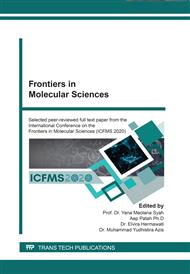[1]
J.R. Jambeck, R. Geyer, C. Wilcox, T.R. Siegler, M. Perryman, A. Andrady, K. L. Law, Plastic waste inputs from land into the ocean, Sci. 347(6223) (2015) 768-771.
DOI: 10.1126/science.1260352
Google Scholar
[2]
S. Kaza, Lisa C. Yao, P. Bhada-Tata, F. Van Woerden, What a Waste 2.0: A Global Snapshot of Solid Waste Management to 2050, World Bank Group, Washington, D.C., (2018).
DOI: 10.1596/978-1-4648-1329-0
Google Scholar
[3]
S.E. Rist, K. Assidqi, N. P. Zamani, D. Appel, M. Perschke, M. Huhn, M. Lenz, Suspended micro-sized PVC particles impair the performance and decrease survival in the Asian green mussel Perna viridis, Mar. Pollut. Bull. 111 (2016) 213-220.
DOI: 10.1016/j.marpolbul.2016.07.006
Google Scholar
[4]
M. Ogonowski, C. Schür, Å. Jarsén, E. Gorokhova, The effects of natural and anthropogenic microparticles on individual fitness in Daphnia magna, PLoS One. 11 (2016).
DOI: 10.1371/journal.pone.0155063
Google Scholar
[5]
M. Cole, P. Lindeque, E. Fileman, C. Halsband, T. Galloway, The impact of polystyrene microplastics on feeding, function and fecundity in the marine copepod Calanus helgolandicus, Environ. Sci. Technol. 49 (2015) 1130-1137.
DOI: 10.1021/es504525u
Google Scholar
[6]
R. Hertadi, K. Kurnia, W. Falahudin, M. Puspasari, Poly-hydroxybutyrate (PHB) production by Halomonas elongata BK AG 18 indigenous from salty mud crater at central Java Indonesia, Malays. J. Microbiol.
DOI: 10.21161/mjm.88416
Google Scholar
[7]
M. Ré, M. Rodrigues, E. Sabino, I. Castro, A. Simioni, M. Pelisson, M. Beltrame, A. Tedesco, New PHB/PHPE microspheres obtained from Burkholderia cepacia as biodegradable drug delivery systems for photodynamic therapy, Rev Minerva Biotechnol. 18 (2006) 3-9.
Google Scholar
[8]
G. Ross, S. Ross, B. J. Tighe, Bioplastics: New Routes, New Products, in: M. Gilbert, Brydson's Plastics Materials, Butterworth-Heinemann, United Kingdom, 2017, pp.631-650.
Google Scholar
[9]
A. Bhuwal, G. Yadav, N. Aggarwal, V. Goyal, A. Yadav, Isolation and Screening of Polyhydroxyalkanoates Producing Bacteria from Pulp, Paper, and Cardboard Industry Wastes, Int. J. Biomater. (2013) 1-10.
DOI: 10.1155/2013/752821
Google Scholar
[10]
R. Verlinden, D. Hill, M. A. Kenward, C. Williams, I. Radecka, Bacterial synthesis of Biodegradable polyhydroxyalkanoates, J. Appl. Microbiol. 102 (2007) 1437-1449.
DOI: 10.1111/j.1365-2672.2007.03335.x
Google Scholar
[11]
P. Spiekermann, B. H. Rehm, R. Kalscheuer, D. Baumeister, A. Steinbüchel, A sensitive, viable-colony staining method using Nile red for direct screening of bacteria that accumulate polyhydroxyalkanoic acids and other lipid storage compounds, Arch. Microbiol. 171 (1999) 73-80.
DOI: 10.1007/s002030050681
Google Scholar
[12]
C.A. Petti, C.R. Polage, P. Schreckenberger, The role of 16S rRNA gene sequencing in identification of microorganisms misidentified by conventional methods, J. Clin. Microbiol. 43 (2005) 6123-6125.
DOI: 10.1128/jcm.43.12.6123-6125.2005
Google Scholar
[13]
D. Rohini, S. Phadnis, S. Rawal, Synthesis and characterization of poly-β-hydroxybutyrate from Bacillus thuringiensis R1, Indian J. Biotechnol. 5 (2005) 276-283.
Google Scholar
[14]
P. J. Barham, A. Keller, E. L. Otun, P. A. Holmes, Crystallization and morphology of a bacterial thermoplastic: poly-3-hydroxybutyrate, J. Mater. Sci. 19 (1984) 2781-2794.
DOI: 10.1007/bf01026954
Google Scholar
[15]
S. Desouky, H. El-Shiekh, M. Elabd, A. Shehab, Screening, Optimization and Extraction of Polyhydroxyalkanoates(PHAs) from Bacillus thuringienesis, J. Adv. Biol. Biotechnol. 1 (2014) 40-54.
DOI: 10.9734/jabb/2014/12286
Google Scholar
[16]
T. R. Shamala, M. S. Divyashree, R. Davis, K. S. L. Kumari, S. V. N. Vijayendra, B. Raj, Production and characterization of bacterial polyhydroxyalkanoate copolymers and evaluation of their blends fourier transform infrared spectroscopy and scanning electron microscopy, Indian J. Micribiol. 49 (2009) 251-258.
DOI: 10.1007/s12088-009-0031-z
Google Scholar
[17]
M.A. Hasan, E.K. Bakhiet, S.G. Ali, H.R. Hussein, Production and Characterization of polyhydroxybutyrate(PHB) produced by Bacillus sp. isolated from Egypt, J. Appl. Pharm. 6 (2016) 46-51.
DOI: 10.7324/japs.2016.60406
Google Scholar
[18]
J. H. Dhangdhariya, S. Dubey, H. B. Trivedi, I. Pancha, J. K. Bhatt, B. P. Dave, S. Mishra, Polyhydroxyalkanoate from marine Bacillus megaterium using CSMCRT's Dry Sea Mix as a novel growth medium, Int. J. Biol. Macromol. (2015) 1-21.
DOI: 10.1016/j.ijbiomac.2015.02.009
Google Scholar


